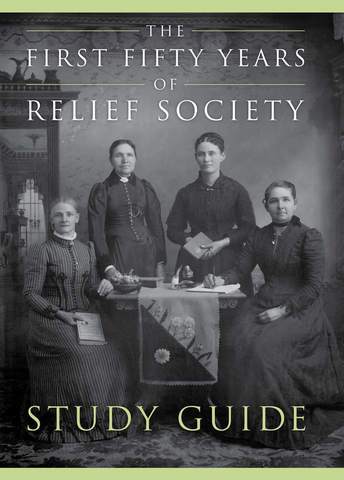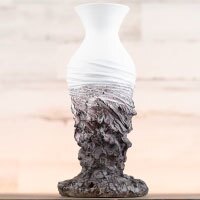“To give instruction, where instruction’s voice
Will guide the feet and make the heart rejoice—”
—Eliza R. Snow (The First Fifty Years, 1.4, 135)
In most 19th-century American churches, male ministers presided over a prevalence of female congregants. Women were the “backbone of the church”—essential, but often invisible in matters of church leadership.1 The role of women was a consistently contested subject in many different denominations. Early in the Restoration, the Lord revealed through Joseph that Emma was to “expound scriptures, and to exhort the church” (D&C 25:7; see also FFY 1.1). In the last verse of that revelation, the Lord says, “This is my voice unto all” and teaches us that though this was important for Emma specifically, as revelatory scripture it likewise applied to all. This revelation was read the day of the Nauvoo Relief Society organization, guiding women to take a more active role in church life (see FFY 1.2.1, 32). In The First Fifty Years we see women repeating these injunctions as a standard for female participation in the Church of Christ and putting them into action as they move forward upon the inspiration of the Spirit to expound and exhort the Saints.
Revelation, July 1830 (Doctrine and Covenants 25) (1.1)
Emma Smith chose to be baptized a member of the newly restored Church of Christ at the end of June 1830. Sometime the following month, Emma’s husband, Joseph, received the revelation now found in section 25 of the Doctrine and Covenants—the only section addressed to a woman. The Lord names Emma as his “daughter” and explains her position as His joint-heir, for “all those who receive my gospel are sons and daughters in my kingdom” (D&C 25:1). Emma had just entered into a covenant relationship with the Lord, and He revealed to her “concerning [His] will” (D&C 25:2). Through the revelation, the Lord offered intimate guidance and comfort as well as outlining expectations for her character and comportment, addressed concerns, and entrusted her with specific duties. Some of these tasks would take years; Emma’s collection of hymns was published nearly six years later in preparation for the Kirtland Temple dedication.
Emma likely heard the admonition to “expound scriptures, and to exhort the church, according as it shall be given thee by my Spirit” in a distinctive way because of her prior experience (D&C 25:7).2 Like many early Latter-day Saints, Emma came from a Methodist background, which offers us specific insight into how Emma understood this call from the Lord. Within the Methodist tradition, women were often called as exhorters to share “one’s testimony of conversion or relating life experiences in the faith, with the goal of imploring one’s listeners toward greater holiness and fuller service.”3 However, in most Methodist congregations, preaching (or expounding and explaining scripture) was seen exclusively as the duty of licensed male ministers. This calling to “expound scripture”—to explain and interpret the meaning of scripture—may have been uncomfortable for Emma considering her prior beliefs.
Elsewhere, elders had been given the revelatory responsibility “to teach, expound, [and] exhort” (D&C 20:42). In the Restoration, exhorting and expounding became the responsibility of both women and men. Biographer Bruce C. Hafen commented that Elder Neal A. Maxwell was fond of saying that “for too long in the Church, the men have been the theologians while the women have been the Christians.”4 The Lord asks all of His disciples to be charitable as well as to expand our capacity to understand and teach scripture and testify one to another. How well do we follow that admonition today, both personally and collectively? Does one of those responsibilities come more easily for you? How can you improve on the other? How are Emma’s responsibilities similar to your own? Do you know what mission the Lord has given you? Has the Lord ever called you to do something that was not initially comfortable for you? Why is this a valuable experience—to learn to do hard things?
Indianola Ward Relief Society, Minutes, 16 September 1880 (4.7)
The Relief Society of Indianola, Utah, was comprised of white and Native American women. The white sisters saw this as an opportunity to share the gospel and civilize their Indian sisters. A product of their time, they regrettably denigrated Native culture. Nevertheless, they simultaneously valued the voice and experience of all and were the first to include American Indian women in Relief Society leadership.
How do we ensure that all feel welcome to expound and exhort? How do we value the voices and experiences of all our sisters, not just those like us? How do we resist the impulse to make others in our own image? Can you think of a time when you learned something significant from someone with a life experience very different from your own?
Eliza’s well-known hymn, now called “O My Father,” teaches the doctrine of a Heavenly Mother. Eliza and others learned of this doctrine from Joseph Smith as he taught them privately before his death.5 She wrote the hymn, initially a poem, upon the death of her own father.6 Her teaching became the source for many to learn of a Mother in Heaven. When put to music in 1852, her hymn expanded the vision of the Saints to better understand themselves and their Heavenly Parents. Eliza used poetry to expound truth to others; how do you testify and teach others? Eliza’s poem expounds theological questions as it works to better understand God. What kinds of questions does she ask? What kinds of answers does she receive and share with others?
“Woman’s Exponent: A Utah Ladies’ Journal,” 1 June 1872 (3.21)
Though not an official Church publication, from 1872 to 1914 the Woman’s Exponent was the Relief Society’s newspaper. An early advertisement for the paper detailed, “The women of Utah are to-day unquestionably more the subject of comment than those of any other portion of the country, or indeed the world. As they have long exercised the right to think and act for themselves, so they now claim the right to speak for themselves through the potent medium of types.” When Emmeline Wells took over the editorship of the paper, Brigham Young charged her to publish “the record of [women’s] work and a portion of Church history” and gave her “a mission to write brief sketches of the lives of the leading women of Zion, and publish them.”7As the women of Utah contributed to the newspaper, they exhorted and expounded: they shared their experiences and testimonies, they theologized and interrogated scripture, and they taught one another. These women’s witnesses reach through time to us. They exemplify the duty of women of the Restoration to “speak up and speak out,” as President Russell M. Nelson has recently implored.8 How do you find opportunities to teach and testify? Eliza and Emmeline spoke up and spoke out in different ways. How is your voice distinct? What do you contribute that no one else can? When the Spirit directs you to share with others, how do you speak up even when it makes you feel vulnerable? How do we become conversant enough to “expound scripture”? Is there value in sharing even when it is difficult? How do we leave a record of our exhorting and expounding?

Buy The First Fifty Years of Relief Society and Receive the Digital Study Guide Free!
To get your free Study Guide ebook,add the hardcover book to your cart. The Study Guide ebook will be automatically added to your cart. Then when you check out, the promo code will be automatically applied on the Purchase page.
In 2016, the Church Historian’s Press published a long-awaited collection of 19th-century Latter-day Saint women’s documents—an institutional history of the Relief Society from 1842 to 1892. The First Fifty Years of Relief Society is a resource to scholars and general readers, placing women with men at the forefront of the Church. But its physical heft and scholarly composition can easily intimidate a general reader. This eBook study guide is a starting point for readers to better understand these essential documents and have conversations about what they mean for us today. Highlighting some of the more outstanding teachings and insights from the book, this guide will help you connect with your Relief Society sisters of the past and apply their wisdom and knowledge to your daily life.
Additional Documents
1.2 Female Relief Society of Nauvoo Minutes: 1.2.9 19 May 1842; 1.2.25 5 August 1843; 1.2.26 13 August 1843; 1.2.30 15 September 1843
2.6 Cedar City Ward Relief Society, Minutes, 10 December 1857, and 11 March 1858
3.16 Ladies’ Cooperative Retrenchment Meeting, Minutes, 19 February 1870
3.19 Nephi Ward Relief Society, Minutes, August-September 1870
4.25 Emery Stake Relief Society, Report, 17 October 1890
Additional Reading
Sheri Dew, “As Women of God, Shall We Not Go Forward in So Great a Cause?” BYU Women’s Conference, 2000
Jennifer Reeder and Kate Holbrook, eds., At the Pulpit: 185 Years of Discourses by Latter-day Saint Women (Salt Lake City: Church Historian’s Press, 2017).
Russell M. Nelson, “A Plea to My Sisters,” Ensign, November 2015
Notes
1. “Women are the backbone of the Church” is an old African-American saying applicable to most United States religious groups. See Ann Braude, Women and American Religion (New York: Oxford University Press, 2000), 7.
2. Though today we generally use the word ordain exclusively for priesthood ordination, one definition of ordain in the nineteenth century was “to set apart for an office; to appoint”—though that usage has fallen out of use. It is one example of how word usage and definitions shift over time. See http://webstersdictionary1828.com/Dictionary/ordain.
3. John W. Wigger, Taking Heaven by Storm: Methodism and the Rise of Popular Christianity in America(New York: Oxford University Press, 1998), 29.
4. Bruce C. Hafen paraphrasing Neal A. Maxwell, Wherefore Ye Must Press Forward, 127, in A Disciple’s Life: The Biography of Neal A. Maxwell (Salt Lake City: Deseret Book, 2002), xx.
5. Jill Mulvay Derr, “The Significance of ‘O My Father’ in the Personal Journey of Eliza R. Snow,” BYU Studies 36, no. 1 (1996-97): 85-126.
6. Jill Mulvay Derr and Karen Lynn Davidson, eds., Eliza R. Snow: The Complete Poetry (Provo, UT, and Salt Lake City, Brigham Young University Press and University of Utah Press, 2009), 312-13.
7. Emmeline B. Wells, “The Jubilee Celebration,” Woman’s Exponent 20, no. 17 (15 March 1892): 132.
8. Russell M. Nelson, “A Plea to My Sisters,” Ensign, November 2015.





